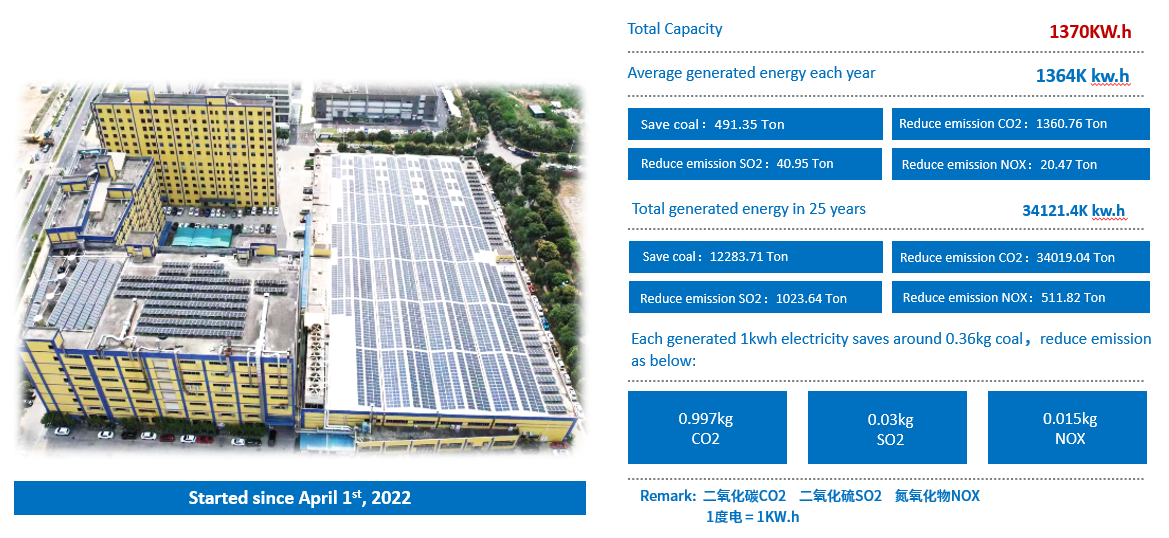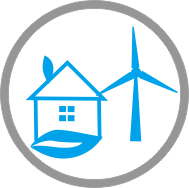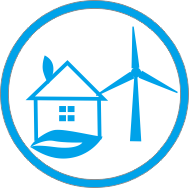Greenhouse Gas Management
In accordance with the scope, categories and calculation methods defined in ISO14064-1:2018, G.Tech carries out inventory and verification of GHG emission sources within the organization's boundaries in accordance with the operational control method.
|
Year |
Scope 1 of emission Volume (t-CO2e) |
Scope 2 of emission Volume (t-CO2e) |
Scope 3 of emission Volume (t-CO2e) |
Total emission volume (t-CO2e) |
|
2021 |
556.85 |
7,416.74 |
386,187.28 |
394,160.87 |
|
2022 |
545.33 |
6,442.77 |
235,526.84 |
242,514.94 |
|
Scope 1: Direct emissions from GHG emission sources owned or controlled by G.Tech. Scope 2: Indirect greenhouse gas emissions from power purchased by G.Tech. Scope 3: Other indirect GHG emissions generated in G.Tech’s value chain, covering the following categories: purchased products and services, fuel and energy activities, upstream traffic and transportation, waste generated in operations, business travel, employee commuting, etc. In the future, we hope to gradually include the certification of more relevant scope 3 emission sources, while ensuring reliable and complete data. |
||||
The table below shows our range of 2022 carbon emissions by scope 3
|
category |
percentage |
|
Outsourcing goods and services |
79.38% |
|
0.09% |
|
|
Fuel and energy-related activities (not included in Scope 1 or Scope 2) |
0.84% |
|
Upstream transportation and distribution |
0.13% |
|
Waste from operational emissions |
0.02% |
|
Business travel |
0.003% |
|
Employee commuting |
0.11% |
|
Downstream transportation and distribution |
1.41% |
|
Use of goods sold |
18.03% |
G.Tech is committed to reducing greenhouse gas emissions in Scope 1 and Scope 2 by 42% by 2030, using 2021 as the base year, and we have made the following efforts to achieve this goal:
1. Green energy
(1) The Company began to install rooftop photovoltaic in October 2021, which was completed and connected to the grid in April 2022, and the cumulative photovoltaic power generation in 2022 is 1,160,129 KWH.
(2) The peripheral lights of the factory are replaced with solar lamps.
2. Green materials
(1) Upgrading of materials and processes to replace toxic and harmful raw materials and reduce the amount of hazardous waste.
(2) Successful use of PCR(post-consumer recycling) plastic and low-carbon aluminum as the shell material of the product, to provide customers with value added and reliable services.
3. Green emission
(1) The new waste gas treatment device has been put into use, mainly UV photolysis purifiers and activated carbon adsorption boxes, to treat the waste gas generated in the production process and then discharge it to reduce environmental pollution.
4. Green recycling
(1) The plastic waste and water feed are crushed and sold, and the waste is reused to reduce the use of raw plastic particle materials.
(2) Pallet recycling.
5. Low-carbon concept
(1) The air conditioner is adjusted to the appropriate temperature (≥ 26 degrees).
(2) Optimize the routes of official cars and shuttles, green travel, reduce the consumption of gasoline and diesel, and reduce exhaust emissions.
(3) Optimize the computer Settings, do not need to switch to sleep mode for a short time; Shutdown is not used for a long time.
(4) Encourage employees to use stairs and minimize the use of elevators.
(5) Promote electronic office and reduce paper printing; Documents that must be printed are printed on both sides.
(6) Promote green office practices, such as the use of video conferencing.
Use of Renewable Energy
Active promotion for 100% use of renewable energy,the company plans to achieve 100% renewable energy use by 2030.
G.Tech started to install roof photovoltaic from Oct, 2021, with a total construction capacity of 1370KW and an average annual power generation of 1.364 million KWh. It was completed and connected to the grid for power generation in April 2022, with an expected annual reduction of 1110 tons of carbon dioxide emission.

Water Resource Management
All water used in G.Tech is water for life, which meets local regulations and has no significant impact on water sources. The Company implements a water resources management plan to record and monitor water resources, their use and discharge. Seek to protect water resources and control pollution channels.
|
Wastewater classification |
Example |
Processing mode |
|
Canteen wastewater |
Oil wastewater |
After the grease trap treatment, and then into the septic tank, treatment standards after discharge to the municipal pipe network |
|
Other life wastewater |
Wastewater of washing room, drinking room, cleaning etc. |
Directly into the septic tank, treatment standards after discharge to the municipal pipe network
|
G.Tech will reduce its water consumption by 22.9% in 2022 compared with 2021.
|
Year |
Usage water(m³) |
Discharge of wastewater treatment |
|
2021 |
139,198 |
125,278.2 |
|
2022 |
107,272.09 |
96,544.88 |
Test result of wastewater of G.Tech in 2022.
|
Test Item |
Test result |
Unit |
Regulatory standard
|
|
|
1# water location ofdomestic wastewaterof south-east door |
2# water location of domestic wastewater |
|||
|
PH |
7.5 |
7.4 |
--- |
6-9 |
|
Chroma |
40 |
40 |
times |
--- |
|
Suspended particle |
32 |
26 |
mg/L |
400 |
|
Chemical oxygen demand |
377 |
257 |
mg/L |
500 |
|
Five-day bod |
181 |
126 |
mg/L |
300 |
|
Ammonia nitrogen |
66.3 |
79 |
mg/L |
--- |
|
Phosphate |
5.03 |
5.21 |
mg/L |
--- |
|
Animal and vegetable oils |
1.86 |
1.02 |
mg/L |
100 |
|
0.05 |
0.05 |
mg/L |
20 |
|
|
0.03 |
0.33 |
mg/L |
2.0 |
|
G.Tech goal:
commitment to reduce water use by 3% per year, with 2021 as the base year.
G.Tech action:
Enhance the awareness of water saving. Change the wrong concept of "inexhaustible" water resources, and firmly establish the value of "saving water is glorious, and wanton waste is shameful".
Strengthen water-saving responsibility. Leaders of all departments should consciously shoulder the responsibility of water-saving work and strive to be the demonstrator and promoter of water conservation. Start from yourself, start from driving colleagues around, actively take the lead in complying with water conservation regulations, and strive to form a good fashion that everyone cares about saving water and always pays attention to saving water.
Do a good job of saving water. Strengthen the daily maintenance and management of water facilities and equipment, and eliminate the phenomenon of "running and dripping" and "long running water". Vigorously promote and use water-saving appliances, eliminate high-water consumption appliances, and strengthen the recycling of water resources, so that a water multi-purpose, qualitative use, reduce water consumption, eliminate waste, and strive to build water-saving units.
Develop water-saving habits. Leaders of all departments should consciously develop the good habit of planning water use, saving water and repeating water use. Saving water is not difficult, everyone can do it. Tighten the faucet, take away the bottled water that can not be finished during the meeting and keep it to drink, and waste less; Use the last glass of water from cleaning the cup or the leftover water from drinking the day before to water the flowers and save a little more; The saved water is collected into a river and a reservoir.
Strengthen water-saving publicity. Through the Posting of water-saving posters and slogans, water-saving education and publicity activities are regularly carried out. In the majority of workers to form a common concern, joint supervision, joint maintenance, common water saving good situation, in order to drive and influence the whole society, improve the whole society to save water, protect water resources awareness, and jointly build a better home.
Waste Management
In accordance with the Law of the People's Republic of China on the Prevention and Control of Environmental Pollution by Solid Waste, We classifies and manages the waste generated during production and operation, and cooperates with qualified professional companies to comply with the classification of waste and minimize the negative impact on the environment.
|
Classification of wastes |
Example |
Processing mode |
|
Non-recyclable waste |
household waste |
Collected, transported and disposed by professional qualified units. |
|
kitchen waste |
kitchen waste |
Disposed harmlessly by professional qualified units. |
|
recyclable waste |
Package carton, metal parts |
By professional by the designated unit regular clearance, equipment scrap metal parts, etc. |
|
hazardous waste |
Scrap board edge, oil stained rag |
Designated storage, entrusted with hazardous waste management qualification units for utilization and disposal |
G.Tech’s waste can be divided into household waste, recyclable waste, hazardous waste and kitchen waste. The total amount of waste in 2022 is 612.37 tons, as shown in the statistical table of waste consumption:
|
Name of index |
Unit |
Year of 2021 |
Year of 2022 |
Disposal |
|
kitchen waste |
Ton |
84.48 |
77.22 |
compost |
|
household waste |
Ton |
70.4 |
71.4 |
landfill |
|
hazardous waste |
Ton |
11.05 |
9.46 |
Recycling, reuse, physicochemical treatment, cleaning, etc. |
|
Recycle waste |
Ton |
517.07 |
454.29 |
Recycle |
|
Number of chemical spills |
Time |
0 |
0 |
|
Target: Commit to reduce the average annual waste generation by 3% by 2021 as the base year.
G.Tech action:
(1) Upgrading of materials and processes to replace toxic and harmful raw materials and reduce the production of hazardous waste.
(2) Reasonable procurement, full use, avoid expired waste, reduce the amount of waste generation.
(3) Choose reusable raw and auxiliary materials, such as packaging, pallets, etc.
(4) The plastic waste and water feed are crushed and sold, and the waste is reused to reduce the use of raw plastic particle materials.
- Home
- Sustainability
- Environment










